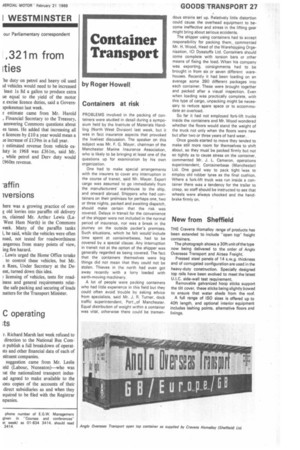Container Transport
Page 29

If you've noticed an error in this article please click here to report it so we can fix it.
by Roger Howell Containers at risk
PROBLEMS involved in the packing of containers were studied in detail during a symposium held by the Institute of Materials Handling (North West Division) last week, but it was in fact insurance aspects that provoked the liveliest discussion. The speaker on this subject was Mr. F. G. Mayer, chairman of the Manchester Marine Insurance Association, who is likely to be bringing at least one of the questions up for examination by his own organization.
One had to make special arrangements with the insurers to cover any interruption in the course of transit, said Mr. Mayer. Export cargo was assumed to go immediately from the manufacturers' warehouse to the ship, and onward abroad. Shippers who had ,containers on their preinises for perhaps one, two or three nights, packed and awaiting dispatch, should make certain that the risk was covered. Delays in transit for the convenience of the shipper were not included in the normal period of insurance, nor was a break in the journey on the outside packer's premises. Such situations, which he felt would'include time spent at containerbases, had to be covered by a special clause. Any interruption in transit not at the option of the shipper was generally regarded as being covered. The fact that the containers themselves were big things did not mean that they could not be stolen. Thieves in the north had even got away recently with a lorry loaded with earth-moving machinery.
A lot of people were packing containers who had little experience in this field but they could often avoid trouble by asking advice from specialists, said M. J. R. Turner, dock traffic superintendent, Port .of Manchester. Equal distribution of weight within a container was vital, otherwise there could be tremen
dous strains set up. Relatively little distortion could cause the overhead equipment to become ineffective and stress in the lifting gear might bring about serious accidents.
The shipper using containers had to accept responsibility for packing them, commented Mr. H. Wood, Head of the Warehousing Organization, ICI Dyestuffs Ltd. Containers should come complete with torsion bars or other means of fixing the load. When his company was exporting, consignments had to be brought in from six or seven different warehouses. Recently it had been loading on an average some 390 different packages into each container. These were brought together and packed after a visual inspection. Even when loading was practically complete, with this type of cargo, unpacking might be necessary to reduce spare space or to accommodate an overload.
So far it had not employed fork-lift trucks inside the containers and Mr. Wood wondered whether the floors would stand the weight of the truck not only when the floors were new but after two or three years of hard wear.
Once goods started to move they tended to make still more room for themselves to shift about, so they must be packed firmly but not so tightly as to cause stress on the container, commented Mr. J. L. Cameron, operations superintendent, Containerbase (Manchester) Ltd. One good way to pack tight ;was to employ old rubber tyres as the final cushion. Where a fork-lift truck was run inside a container there was a tendency for the trailer to creep, so staff should be instructed to see that wheels were always chocked and the handbrake firmly on.
New from Sheffield
THE Cravens Homalloy range of products has been extended to include "open top" freight containers.
The photograph shows a 30ft unit of the type now being delivered to the order of Anglo Overseas Transport arid Airsea Freight.
Pressed steel panels of 14 s.w.g. thickness and of corrugated configuration are used in the heavy-duty construction. Specially designed top rails have been evolved to meet the latest U.I.C. side-wall test requirement.
Removable galvanized hoop sticks support the tilt cover, these sticks being slightly bowed to ensure that water sheds from the roof.
A full range of ISO sizes is offered up to 40ft length., and optional interior equipment includes lashing points, alternative floors and linings.












































































































